| |
"The original idea I had was different from the film as it is now. More violent, more pornographic and more immoral." |
| |
Director Tsukamoto Shinya
interviewed at midnighteye.com* |
Young
phone counselor Rinko is in a sexless marriage with older
businessman Shigehiko. One day she is sent a package containing
illicitly taken photographs of her masturbating, browsing
the internet for dildos, and dressing in a the sort of super-short
mini skirt she would never wear in public. A second set pictures is
accompanied by a phone, through which the photographer Iguchi
contacts her, threatening to show the pictures to her husband
unless she agrees to act out her private fantasies in a public
location. Shigehiko is seemingly unaware of either his wife's fantasies or her present predicament, and has developed an obsession with cleaning, but Iguchi also
has plans for him.
After
the beautifully formal compositions of the 1999 Sōseiji [Gemini], A Snake of June [Tokugatsu no hebi] finds Tetsuo director Tsukamoto Shinya back
in more recognisable territory, shooting in black-and-white (though
here with a steely blue tint) on 16mm and exploring one of his favourite
themes, that of the liberation and destruction of the body,
often via the route of pain and humiliation. This was perhaps
at its most blatant in the 1995 Tokyo
Fist [Tōkyō-ken],
and those familiar with that work will find much that is familiar
in A Snake of June, stylistically as well
as thematically. The film again features a trio of central characters consisting of one female and two males, one of whom is again played by Tsukamoto himself and
all of whom are suppressing emotions that will be externalised
through the process of disruption and manipulation by another
member of this group. The difference here is that Tsukamoto
is dealing with sex rather than violence, and for a portion of the audience
this will change everything. Indeed, it's fair to say that many potential and actual viewers of this film will be put off or react badly
to the its seemingly exploitative use of its central female
character. And they may indeed have a point (which I will
come to in a while), but I suspect some of these very same offended viewers will have
no problem with the violent slaughter on show in the likes
of Kill Bill, and not see that as exploitative
in any way. "It's just a comic book, man!" Well,
this is just a semi-surrealistic erotic body-horror drama.
Man.
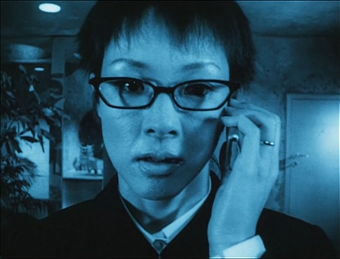
The
film is divided into three chapters by familiar icons representing
male and female, the final chapter featuring the two combined into a unified symbol. It is the first half-hour that
is likely to prove most troublesome for many (dare I say Western)
viewers, as Tsukamoto, both as director and actor, puts
Rinko through the emotional grinder, forcing her to act out what his
character believes are desires that she is suppressing,
so much so that it's on the verge of producing a physical
change in her body. Right from the start Tsukamoto the director
connects us to Rinko by viewing almost everything from her
viewpoint, achieved by shooting her in sometimes uneasily intimate close-up. By the
time he has her walking the street, terrified by the attention
her short dress is attracting, I for one was cringing for
her, and when she returns to a public toilet to change and
cries with frustration my discomfort level was upped a few more notches. And this is before
she is forced to walk the streets wearing and internally located vibrator, which her tormentor is able to trigger remotely...
The
second story is shorter and deals with her husband Shigehiko,
and the narrative shifts into altogether stranger and
perhaps metaphoric territory. Early on, Shigehiko is drugged
and wakes as part of an audience for what appears to be snuff
theatre. The hands of these captive onlookers are manacled behind their backs, their vision
restricted by conical metallic visors strapped to their faces,
and they are forced to watch as a young couple are abused and then drowned
before their eyes. Here Shigehiko is given a preview of is
own future, both in the threat to his life that lays ahead
and his own masturbatory voyeurism when he follows Rinko to
an orgasmic photoshoot in a secluded alley. The snuff theatre
is as surrealistic as the film gets, and it's a startling
leap after the relatively naturalistic tone of the preceding
scenes, a sort of bizarre melding of Terry Gilliam, David
Lynch and City of Lost Children era Caro
and Jeunet.
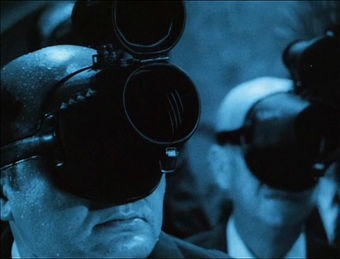
Rinko,
meanwhile, turns things round on her tormentor, taking
control of her own experience and coldly refusing to sympathise
with Iguchi's deteriorating physical state. Increasingly,
Iguchi seems to be a metaphoric figure – he triggers Rinko's
own sexual self-awareness and her discovery of her
own changing body condition, and violently punishes Shigehiko
for a selfishness that may kill Rinko, in part through the use of a biomechanical
tendril that emerges from his decaying stomach. His physical
existence is actually called into question early on in the story when a bullet aimed successfully at him by Shigehiko is revealed
to have pierced nothing more than Shigehiko's own business
suit, while a curious moment has Iguchi placing a photographic
self-portrait next to a shot taken of the room from the very same angle in which he is not present. Is he imagining his eventual
non-existence at the hands of cancer or asking us to reflect
on his unreality? Certainly, there is an artificiality to his
photographic exploits – Rinko is always fabulously lit and
perfectly framed, never more so than in the alley shoot, the
visual splendour of which may almost have been created in
Rinko's own fantasy.
Throughout
the film Tsukamoto uses a circular motif to link every character
and incident. The plug-holes that Shigehiko obsessively cleans,
the round skylight that a bathing Rinko looks through (and
through which she is presumably observed by Iguchi), the conical
visors that are fixed to the faces of the snuff movie audience, the window
on the tank in which the victims are drowned, even the logo
on the drain down which the never-ending June rain pours.
This is open to multiple readings, but seems to be primarily
linked with the whole concept of voyeurism and gender – the
camera lens, flashgun and human iris are also circular, and
the circle is the only common feature of the symbols used
here to represent male and female, and the shape with which both
can be effectively merged into a single icon. Water is also
key, and in interview Tsukamoto has linked the June rains
in Japan with an observably increased eroticism at that time
of year, and to water as a reviving force. It should also be
noted that on the extras disc, Tsukamoto says that water on
skin was always intended to be a key aspect of the film's eroticism.
There
is a great deal that could be written about this film and
I've only touched on a few of the components. The wonderful thing
about a work that does not lay its cards blatantly on the
table is that it lays itself open to multiple interpretations, and Snake
of June certainly qualifies here. Some will find
it exploitative and even offensive, but it has been championed
elsewhere as a feminist work (the same discussion was key
to any reading Miike Takashi's Audition),
and despite the original intentions quoted at the start of
this review, Tsukamoto takes a decidedly restrained approach
to what he shows on screen, keeping the nudity to a minimum
and more often than not using suggestion rather than graphic
presentation.
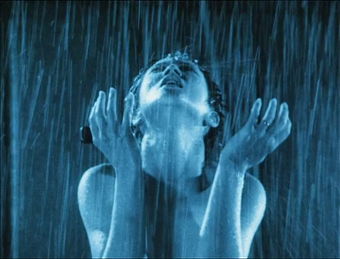
Whether
the film says anything new is debatable, but in the context
of Japanese society, with its emphasis on ritual and surface
politeness, many of these elements do have a contextual freshness.
In the end what sells it is Tsukamoto's typically compelling
use of camera – a combination of formally composed static
shots, drifting wheelchair tracks, and twitchy, long-lens close-ups
– and a brave and utterly committed central performance
from Kurosawa Asuka. This is doubly important in a film of
so few characters, especially as she has to carry the emotional
weight of the film in a role that many would have shied away
from (see extras info for more on this). Though
he has seemingly less to do, Kōtari Yuji delivers when
it counts as Shigehiko, and Tsukamoto himself certainly immerses
himself in the role of cancerous photographer Iguchi. In one of the featurettes
he talks about the diet he undertook to lose enough weight
to play someone dying from cancer, but he's a thin man
at the best of times, and especially considering the film's
overall look you'd be pushed to see that physical transformation
on screen. By the way, that is Kitano Takeshi regular Susumu
Terajima in a cameo role as the cop who accuses Shigehiko
of being a peeping tom and later has his gun stolen.
A Snake of June is not an easy work or an easy sell, but three viewings
in I have become increasingly convinced of its considerable
virtues, despite some lingering apprehension over its presentation
of its central female character, and my own position as a
(male) audience member and voyeur. But maybe that's the point
– a female friend who watched the film was not made to feel
uncomfortable by anything in it; indeed, she described the
overall effect as 'liberating'.
This review looks at two separate DVD releases of the film, a Japanese 2-disc special edition from Happinet, and a UK single disc release from Tartan.
Most
Tsukamoto films present a challenge when reviewing the picture
quality – shot on grainy 16mm, they are unlikely to meet
the standards of sharpness, picture contrast and (well, obviously)
colour we traditionally judge modern films by. I am in no
way making excuses here, but the blue-tinted monochrome and
even the film grain are very much part of this film's visual
aesthetic, and on the whole they are well served by the transfer
on the Happinet Japanese disc. Contrast is generally good,
and though there is the occasional spate of artefacting in
large areas on one shade, I found the transfer very pleasing,
given the limitations set by the print.
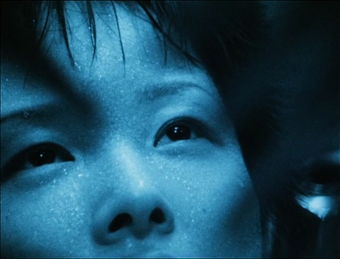
The
Tartan UK release shares many of these limitations, but suffers from less impressive constrast
and a slightly softer picture. This appears to be the result
of an NTSC to PAL transfer (identifiable with ghosted freeze frames,
particularly evident on a computer-based DVD drive). Some highlights
lose fine detail through burn-out, and the blacks, such as
they are, are not quite there. This is particularly evident
in scenes with large areas of shadow, which have a blue-grey
feel to them rather than a blue-black, if you get what I mean.
It's still very watchable, but the Japanese disc is definitely
superior.
Both
Japanese and English subtitles are provided on the Happinet
disc. The English subtitles are decently translated
and always clear, though individual letters seem graphically
a little trimmed on the edges. They are always legible, though,
and you soon forget this. The subtitles on the Tartan disc
are clear and a good size throughout.
There
are two soundtracks available on the Japanese disc, 5.1 and
DTS, both in the original Japanese. The 5.1 is good, but the
DTS track is first rate: rain thunders down from every direction,
flashguns fire with the wallop of canons, and bass tones on
the music track send a room-shaking rumble from the subwoofer.
Tsukamoto uses sound effects and music to excellent effect
and it's been a long road since the mono track of Tetsuo to this fine mix.
Both
of these tracks are included on the Tartan disc, the company
now having made a solid commitment to DTS. In addition, a
Dolby 2.0 track is included, but this is considerably inferior
to the 5.1 and DTS, for obvious reasons.
Here
the two releases are on different planets.
The
UK Tartan release is a bare bones, pretty much movie only
affair. The only real extra of note is the Theatrical Trailer, and it is the original
Japanese one, subtitled in English. This runs for just over
two minutes and is anamorphic 16:9, not the ratio in which the film
was shot but a likely concession to cinemas stringing trailers
together for screening and not wanting to be bothered with lens
or screen mask changes. The usual Tartan trailer reel is also present,
and includes trailers for Tartan's recent releases in the
'Asia Extreme' range and one for Tsukamoto's debut feature, Tetsuo.
The
Japanese release is a two-disc special edition and has a very
decent set of extras, with the film itself on disc 1 and the
bulk of the extras on disc 2. Disc 1 also contains a single extra, Michio's
Album, a gallery of the photos taken by Iguchi
and found in the photo album later in the film. The pictures
themselves are quite large, though not full screen, and though
an interesting extra, the inclusion of Iguchi's voyeuristic
photos of Rinko will no doubt appeal to a small portion of
the film's audience in more than an artistic sense.
Disc
2 has menus in both Japanese and English, but this is where
the cross-cultural assistance ends – none of the extras are
subtitled, severely limiting their usefulness to UK viewers.
This is a damned shame, as they are actually very good and
help shed some light on the thinking behind the film and the
approach to the characters taken by director and stars.
The
main menu have five selections, some of which have sub-menus
within them: Production, Distribution, Theatrical
Trailer, Gallery and Staff and Cast. Production contains two featurettes.
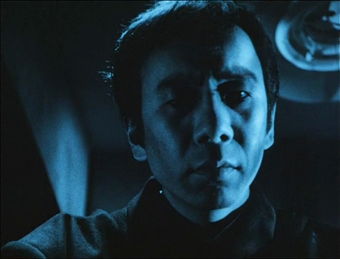
Playing
A Snake of June consists of interviews with
lead players Kurosawa Asuka and Kōtari Yuji, with Tsukamoto
contributing from his standpoint as both a performer and director.
This is all interesting stuff, though Tsukamoto is occasionally
a little willfully obscure, but is most valuable for Asuka
Kurosawa's take on playing a role that that you would think
she had to be almost coerced into accepting. It comes as a considerable
surprise to find that on receiving the script she was immediately
sold, feeling that no other part she had
read had allowed her to express her own feelings and personality
so well. As a result, far from having to be persuaded to take
the part, she actively and aggressively pursued it. The interviews
are shot on 4:3 video and for the most part very sharp and
clear – Tsukamoto and Kōtari at least are photographed
in a brightly lit studio setting against a blue screen, but
Kurosawa has been filmed in the more dingy setting of a TV
control room, with extracts of the film playing behind her
on multiple monitors. The interviews run for almost 20 minutes
in total.
Shooting
A Snake of June is also shot 4:3 on video and also runs for almost 20 minutes.
A fair amount of ground is covered here, including the decision
to film using a 'square' format, the choice of a duotone blue
for the look of the film, the repeated use of the circle motif,
and the creation of constant heavy rain (which was achieved
by spraying water into the air with a collection of garden
hoses rather than with some sophisticated and expensive rain
machines). There are a wider variety of interviews here, and
include those involved in creating the film's look, sound
effects and music. Again this is interesting stuff and expands
beyond the interviews to include on-set photographs
and even a brief musical performance by the composer of the
film's score, Ishikawa Chu. It's still going to prove hard
work for non-Japanese speakers.
Distribution also has two featurettes, the first of which, Welcome
Back Tsukamoto, is shot on 4:3 video, runs for
14 minutes and takes a look at Tsukamoto's
career and his personal marketing of A Snake of June through film festival appearances. Narrated by Kōtari Yuji,
sometimes straight to camera from the blue-screen location
of the other featurettes, it starts off with a collection
of stills but soon moves into video footage of Tsukamoto and
his lead players at the 59th Mostra Internationale d'Arte
Cinematographica in Venice in 2002, where the film won the San Marco
Special Jury Award and the Kinematrix Film Award. This includes
the screening of the film itself and the ovation it received afterwards,
plus a flavour of the press coverage of Tsukamoto.
One nice bit has Tsukamoto up for an award and reluctant to step forward until the DV cameraman who is shooting
this footage is ready to film, then read his thanks in Italian
from notes written on the palm of his hand.
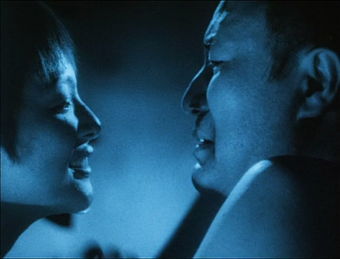
A
Snake of June in Tokyo runs for just 3 minutes and has Tsukamoto, Kurosawa and Kōtari
attending various screenings, functions and even shops in
Tokyo. Though a little more superficial than the preceding
featurette, the trip to HMV does give a glance of the sort
of merchandising that has been attached to the film, with
a neat 3D display (the facial cones are emerging from a 2D
image) and a selection of T-shirts, billboards and posters
of the sort we in the West associate more with big Hollywood
films. I'm already chasing after one of the T-shirts – this
disc set did come with a brochure containing a very wide selection
of marketing materials.
There
are two Theatrical Trailers – a
40 second teaser trailer and the final release trailer, which
runs for close to 2 minutes. The full trailer gives a fair
flavour of the film itself, but curiously both are formatted
non-anamorphic 1.85:1.
The Gallery has three sub-sections: Award contains pictures of the awards won by the
film; Materials has some of the fliers and posters
used to promote the film and Item contains some of
the associated merchandising materials, though by no means
all of them. An OK gallery, but thin. I'd like to have seen
that 3D display board in here. I'd like to have that
3D display board!
Finally Staff and Cast has brief biographies
and filmographies for Tsukamoto, Kurosawa, Kōtari and
Chu Ishikawa, who has composed the scores for all Tsukamoto's
films to date.
A
Snake of June is only going to find a specialist audience in the UK, and
viewers are going to have problems with it, but I would
urge those with a taste for the unusual to give it a try,
as there is a reasonable chance you might really like it.
Tsukamoto fans need no urging – the man is a one of the most
compelling filmmaers in modern cinema, and A
Snake of June is riddled with elements both familiar
and unexpected, exploring the director's favourite themes
but from a different, potentially more confrontational angle.
And technically it's as assured as ever – Tsukamoto may have
calmed down a tad since Tetsuo, but he's
still way out there and making the sort of films we celebrate
here at Outsider.
The
Tartan disc does well on sound, but is a tad wanting on picture,
thanks to what looks like (another) NTSC to PAL pulldown.
The lack of extras is disappointing, especially considering
the number on the Japanese release, but it's unlikely
Tartan could fork out for the subtitling of these features,
especially considering Tsukamoto's still small cult status
here. Fortunately, he is more widely acclaimed in his native
Japan and the Happinet 2-disc 'premium' release boasts some
really interesting stuff, but unless you know your way around
the Japanese language then there will be little advantage
of coughing up for this version (though the picture definitely
has the edge). For those of you that can speak the lingo,
or know someone who can, then my advice is to finds someone
who is travelling to Japan soon and ask them to pick it up
(or send it to you – thanks again, Hiro-san!), as the cost
of importing it is pretty steep at present.
The Japanese convention of family name first has been used throughout this review.
|